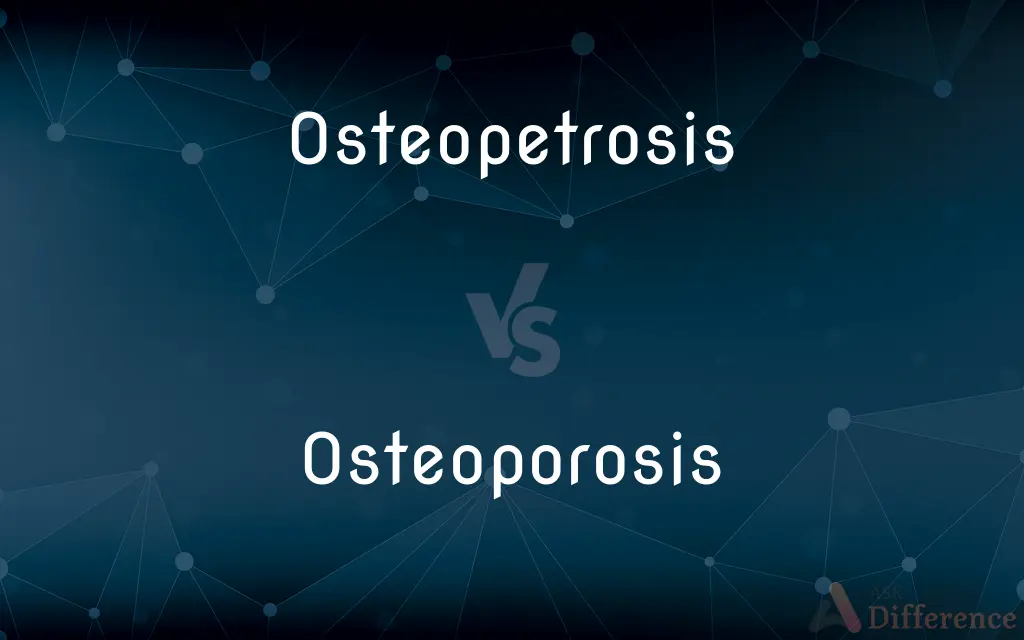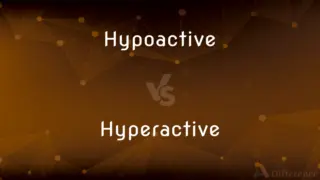Osteopetrosis vs. Osteoporosis — What's the Difference?
By Urooj Arif & Fiza Rafique — Updated on April 22, 2024
Osteopetrosis involves abnormal bone hardening and density increase, whereas osteoporosis is characterized by bone weakening and decreased density.

Difference Between Osteopetrosis and Osteoporosis
Table of Contents
ADVERTISEMENT
Key Differences
Osteopetrosis is a rare condition where bones become overly dense and brittle due to defective bone resorption, leading to potential fractures. Whereas, osteoporosis is a common condition characterized by decreased bone density and increased fragility, also leading to fractures.
In osteopetrosis, the bones appear radiologically denser on X-rays. On the other hand, in osteoporosis, bones show increased porosity and thinning on scans.
Treatment for osteopetrosis can involve managing symptoms and complications as there is no cure, whereas osteoporosis management includes medication to slow bone loss and dietary changes to strengthen bones.
Osteopetrosis often requires careful clinical management to prevent bone marrow failure and other complications, whereas osteoporosis primarily focuses on preventing fractures and maintaining functional mobility.
Comparison Chart
Definition
Increased bone density and fragility
Decreased bone density and increased fragility
ADVERTISEMENT
Radiological Appearance
Bones appear overly dense
Bones show increased porosity and thinning
Complications
Fractures, bone marrow failure
Fractures, especially in hip, wrist, and spine
Treatment Focus
Managing symptoms, no cure
Slowing bone loss, dietary changes, and supplements
Compare with Definitions
Osteopetrosis
Genetic.
Osteopetrosis is often inherited, with symptoms appearing early in life.
Osteoporosis
Lifestyle impact.
Osteoporosis has led her to modify her daily activities to avoid falls.
Osteopetrosis
Excessive bone density.
Osteopetrosis resulted in his bones being unusually dense and prone to fracture.
Osteoporosis
Common in elderly.
He was diagnosed with osteoporosis, a common issue for those his age.
Osteopetrosis
Brittle bones.
Despite their density, her bones are brittle due to osteopetrosis.
Osteoporosis
Preventative care.
She takes calcium and vitamin D to combat her osteoporosis.
Osteopetrosis
Complication risk.
Osteopetrosis can complicate surgeries due to the unusual hardness of bones.
Osteoporosis
Bone loss.
Osteoporosis causes her to lose bone density, increasing fracture risk.
Osteopetrosis
Osteopetrosis, literally "stone bone", also known as marble bone disease or Albers-Schönberg disease, is an extremely rare inherited disorder whereby the bones harden, becoming denser, in contrast to more prevalent conditions like osteoporosis, in which the bones become less dense and more brittle, or osteomalacia, in which the bones soften. Osteopetrosis can cause bones to dissolve and break.It is one of the hereditary causes of osteosclerosis.
Osteoporosis
Treatment options.
Medications to slow bone density loss are common treatments for osteoporosis.
Osteopetrosis
(pathology) A rare hereditary disorder characterized by hard, dense bones.
Osteoporosis
Osteoporosis is a systemic skeletal disorder characterized by low bone mass, micro-architectural deterioration of bone tissue leading to bone fragility, and consequent increase in fracture risk. It is the most common reason for a broken bone among the elderly.
Osteopetrosis
An inherited disorder characterized by an increase in bone density; in severe forms the bone marrow cavity may be obliterated
Osteoporosis
A disease characterized by a decrease in bone mass and density, occurring especially in postmenopausal women, resulting in a predisposition to fractures.
Osteoporosis
(pathology) A disease, occurring especially in women following menopause, in which the bones become extremely porous and are subject to fracture.
Osteoporosis
An absorption of bone so that the bone tissue becomes unusually porous. It occurs especially in elderly men and postmenopausal women, and predisposes the elderly to fractures of the bones.
Osteoporosis
Abnormal loss of bony tissue resulting in fragile porous bones attributable to a lack of calcium; most common in postmenopausal women
Common Curiosities
What causes osteopetrosis?
Osteopetrosis is caused by defective osteoclasts that fail to resorb bone.
What are the risk factors for osteoporosis?
Risk factors include age, gender (more common in women), poor diet, and inactivity.
How are the treatments for osteopetrosis and osteoporosis different?
Osteopetrosis treatment focuses on symptom management; osteoporosis treatments aim to slow or reverse bone loss.
Can children have osteopetrosis?
Yes, there are congenital forms of osteopetrosis that appear in infancy or childhood.
How is osteoporosis diagnosed?
Osteoporosis is diagnosed through bone density scans, often detected after a minor fracture.
What is the prognosis for someone with osteopetrosis?
The prognosis varies widely based on the form of osteopetrosis and its severity.
What lifestyle changes can help manage osteoporosis?
Increased calcium intake, regular exercise, and avoiding smoking and excessive alcohol can help.
How can osteoporosis be prevented?
Preventative measures include maintaining a healthy diet rich in calcium and vitamin D, regular exercise, and lifestyle modifications.
Is osteopetrosis curable?
There is no cure for osteopetrosis; treatment usually focuses on managing symptoms and complications.
What dietary supplements are recommended for osteoporosis?
Calcium and vitamin D are commonly recommended to help strengthen bones.
Can osteoporosis lead to other health issues?
Yes, osteoporosis can lead to severe fractures, which may cause prolonged disability.
Share Your Discovery

Previous Comparison
Hypoactive vs. Hyperactive
Next Comparison
Fruitless vs. UnfruitfulAuthor Spotlight
Written by
Urooj ArifUrooj is a skilled content writer at Ask Difference, known for her exceptional ability to simplify complex topics into engaging and informative content. With a passion for research and a flair for clear, concise writing, she consistently delivers articles that resonate with our diverse audience.
Co-written by
Fiza RafiqueFiza Rafique is a skilled content writer at AskDifference.com, where she meticulously refines and enhances written pieces. Drawing from her vast editorial expertise, Fiza ensures clarity, accuracy, and precision in every article. Passionate about language, she continually seeks to elevate the quality of content for readers worldwide.














































